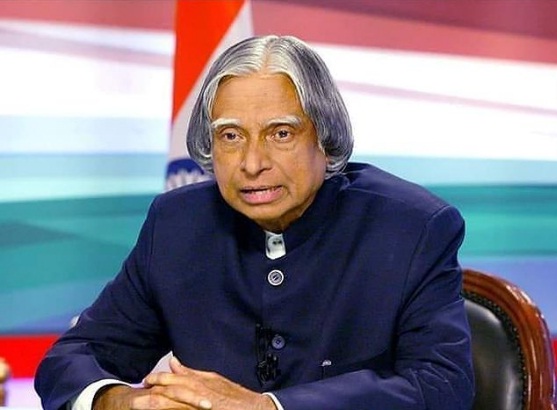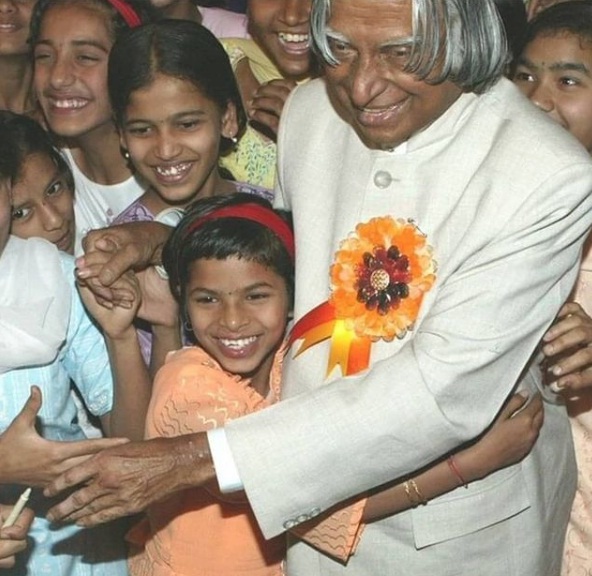APJ Abdul Kalam Biography
Avul Pakir Jainulabdeen Abdul Kalam was an Indian aviation researcher who filled in as the eleventh President of India from 2002 to 2007. APJ Abdul Kalam was born on 15th October 1931 and He was brought up in Rameswaram, Tamil Nadu, and considered material science and aeronautic design. He went through the following forty years as a researcher and science head, mostly at the Defense Research and Development Organization (DRDO) and Indian Space Research Organization (ISRO), and was personally engaged with India's regular citizen space program and military rocket improvement efforts. He hence came to be known as the Missile Man of India for his work on the advancement of ballistic rocket and dispatch vehicle technology. He additionally played an urgent authoritative, specialized, and political job in India's Pokhran-II atomic tests in 1998, the first since the first atomic test by India in 1974.
APJ Abdul Kalam was chosen as the eleventh President of India in 2002 with the help of both the decision Bharatiya Janata Party and the then-resistance Indian National Congress. Generally alluded to as "Individuals' President" he got back to his regular citizen life of instruction, composing, and public help after a solitary term. He was a beneficiary of a few lofty honors, including the Bharat Ratna, India's most elevated non-military personnel honor.
While conveying a talk at the Indian Institute of Management Shillong, Kalam imploded and passed on from an evident heart failure on 27 July 2015, matured 83. Thousands, including public-level dignitaries, going to the memorial service function held in his old neighborhood of Rameswaram, where he was covered with full state honours.
Early life and training
Avul Pakir Jainulabdeen Abdul Kalam was brought into the world on 15 October 1931 to a Tamil Muslim family in the journey focal point of Rameswaram on Pamban Island, at that point in the Madras Presidency and now in the State of Tamil Nadu. His dad Jainulabdeen Marakayar was a boat proprietor and imam of a nearby mosque; his mom Ashiamma was a housewife. His dad possessed a ship that took Hindu travelers to and fro among Rameswaram and the now uninhabited Dhanushkodi. Kalam was the most youthful of four siblings and one sister in his family. His precursors had been well off Marakayar merchants and landowners, with various properties and huge plots of land. Despite the fact that his precursors had been rich Marakayar merchants, the family had lost the majority of its fortunes by the 1920s and was destitution blasted when Kalam was conceived. Marakayar is a Muslim ethnic found in waterfront Tamil Nadu and Sri Lanka who guarantee descendance from Middle Easterner dealers and nearby ladies. Their business had included exchanging staple goods between the territory and the island and to and from Sri Lanka, just as shipping explorers between the terrain and Pamban. As a little youngster, he needed to offer papers to add to the family's pitiful pay. With the kickoff of the Pamban Bridge to the territory in 1914, nonetheless, the organizations fizzled and the family fortune and properties were lost over the long haul, aside from the familial home.
In his school years, Kalam had normal evaluations yet was portrayed as a brilliant and dedicated understudy who wanted to learn. He went through hours on his examinations, particularly mathematics. After finishing his schooling at the Schwartz Higher Secondary School, Ramanathapuram, Kalam proceeded to go to Saint Joseph's College, Tiruchirappalli, at that point partnered with the University of Madras, from where he graduated in material science in 1954. He moved to Madras in 1955 to consider advanced plane design at the Madras Institute of Technology. While Kalam was chipping away at a senior class project, the Dean was disappointed with his absence of progress and took steps to deny his grant except if the task was done within the following three days. Kalam fulfilled the time constraint, intriguing the Dean, who later said to him, "I was putting you under pressure and requesting that you meet a troublesome deadline". He barely missed accomplishing his fantasy about turning into a military pilot, as he put 10th in qualifiers, and just eight positions were accessible in the IAF.
APJ Abdul Kalam profession as a researcher
This was my first stage, where I took in administration from three incredible educators—Dr. Vikram Sarabhai, Prof Satish Dhawan, and Dr. Brahm Prakash. This was the hour of learning and obtaining information for me.
A P J Abdul Kalam In the wake of moving on from the Madras Institute of Technology in 1960, Kalam joined the Aeronautical Development Establishment of the Defense Research and Development Organization (by Press Information Bureau, Government of India) as a researcher in the wake of turning into an individual from the Defense Research and Development Service (DRDS). He began his profession by planning a little air cushion vehicle, yet stayed unconvinced by his decision of a task at DRDO. Kalam was likewise important for the INCOSPAR board working under Vikram Sarabhai, the prestigious space scientist. In 1969, Kalam was moved to the Indian Space Research Organization (ISRO) where he was the undertaking overseer of India's first Satellite Launch Vehicle (SLV-III) which effectively sent the Rohini satellite in close earth circle in July 1980; Kalam had initially begun work on an expandable rocket project freely at DRDO in 1965. In 1969, Kalam got the public authority's endorsement and extended the program to incorporate more engineers.
Kalam tends to design understudies at IIT Guwahati
From 1963 to 1964, he visited NASA's Langley Research Center in Hampton, Virginia; Goddard Space Flight Center in Greenbelt, Maryland; and Wallops Flight Facility. Between the 1970s and 1990s, Kalam put forth an attempt to build up the Polar Satellite Launch Vehicle (PSLV) and SLV-III ventures, the two of which end up being effective.
APJ Abdul Kalam was welcomed by Raja Ramanna to observe the country's first atomic test, Smiling Buddha, as the delegate of TBRL, despite the fact that he had not taken an interest in its turn of events. During the 1970s, Kalam likewise coordinated two tasks, Project Devil and Project Valiant, which tried to create ballistic rockets from the innovation of the fruitful SLV program. Despite the dissatisfaction with regards to the Union Cabinet, Prime Minister Indira Gandhi allocated secret assets for these aviation projects through her optional forces under Kalam's directorship. Kalam assumed a vital part in persuading the Union Cabinet to disguise the real essence of these characterized aviation projects. His exploration and instructive administration brought him extraordinary shrubs and esteem during the 1980s, which provoked the public authority to start a high-level rocket program under his directorship. Kalam and Dr. V S Arunachalam, metallurgist and logical guide to the Defense Minister, chipped away at the idea by the then Defense Minister, R. Venkataraman on a proposition for synchronous advancement of a bunch of rockets as opposed to taking arranged rockets one after another. R Venkatraman was instrumental in getting the bureau endorsement for designating ₹ 3.88 billion for the mission, named Integrated Guided Missile Development Program (IGMDP), and delegated Kalam as the boss executive. Kalam had a significant influence in creating numerous rockets under the mission including Agni, a middle-of-the-road-range ballistic rocket, and Prithvi, the strategic surface-to-surface rocket, albeit the activities have been condemned for blunder and cost and time overruns.
APJ Abdul Kalam filled in as the Chief Scientific Adviser to the Prime Minister and Secretary of the Defense Research and Development Organization from July 1992 to December 1999. The Pokhran-II atomic tests were directed during this period wherein he assumed a concentrated political and mechanical part. Kalam filled in as the Chief Project Coordinator, alongside Rajagopala Chidambaram, during the testing phase. Media inclusion of Kalam during this period made him the nation's most popular atomic scientist. However, the head of the site test, K Santhanam, said that the nuclear bomb had been a "misfire" and scrutinized Kalam for giving a wrong report. Both Kalam and Chidambaram excused the claims.
In 1998, alongside cardiologist Soma Raju, Kalam built up a minimal expense coronary stent, named the "Kalam-Raju Stent". In 2012, the pair planned a tough tablet PC for medical services in country zones, which was named the "Kalam-Raju Tablet"
A. P. J. Abdul Kalam Books
In his book India 2020, Kalam firmly supported an activity intend to form India into an "information superpower" and a created country continuously 2020. He respected his work on India's atomic weapons program as an approach to attest India's place as a future superpower.
I have distinguished five zones where India has a center capability for incorporated activity: (1) agribusiness and food preparing; (2) instruction and medical services; (3) data and correspondence innovation; (4) framework, solid and quality electric force, surface vehicle and foundation for all pieces of the nation; and (5) confidence in basic advances. These five territories are intently between related and whenever progressed in an organized manner, will prompt food, financial and public safety.
Kalam portrays an "extraordinary second" in his life when he asked Pramukh Swami, the master of the BAPS Swaminarayan Sampradaya, how India may understand this five-pronged vision of improvement. Pramukh Swami's answer—to add a 6th territory creating confidence in God and otherworldliness to beat the current environment of wrongdoing and debasement—turned into the profound vision for the following 15 years of Kalam's life, which he depicts in his last book, Transcendence: My Spiritual Experiences with Pramukh Swamiji, distributed only a month prior to his death.
It was accounted for that there was extensive interest in South Korea for interpreted variants of books composed by him. Abdul Kalam took a functioning interest in different improvements in the field of science and innovation, including an exploration program for creating biomedical inserts. He likewise upheld open source innovation over exclusive programming, anticipating that the utilization of free programming for an enormous scope would carry the advantages of data innovation to more people.
Kalam set an objective of collaborating with 100,000 understudies during the two years after his abdication from the post of logical counselor in 1999. He clarified, "I feel good in the organization of youngsters, especially secondary school understudies. From now on, I expect to impart to their encounters, assisting them with touching off their creative mind and setting them up to work for a created India for which the guide is now accessible." His fantasy is to let each understudy illuminate the sky with triumph utilizing their inactive fire in the heart.
Awards & Honours
APJ Abdul Kalam got 7 privileged doctorates from 40 universities. The Government of India regarded him with the Padma Bhushan in 1981 and the Padma Vibhushan in 1990 for his work with ISRO and DRDO and his part as a logical counselor to the Government. In 1997, Kalam got India's most noteworthy nonmilitary personnel honor, the Bharat Ratna, for his commitment to the logical exploration and modernization of protection innovation in India. In 2013, he was the beneficiary of the Von Braun Award from the National Space Society "to perceive greatness in the administration and initiative of a space-related project".
In 2012, Kalam was positioned number 2 in Outlook India's survey of the Greatest Indian.
Following his demise, Kalam got various recognitions. The Tamil Nadu state government declared that his birthday, 15 October, would be seen across the state as "Youth Renaissance Day;" the state government further founded the "Dr. A. P. J. Abdul Kalam Award", comprising an 8-gram gold decoration, a declaration and ₹500,000 (US$7,000). The honor will be granted every year on Independence Day, starting in 2015, to inhabitants of the state with accomplishments in advancing logical development, the humanities or the government assistance of students.
On the commemoration of Kalam's introduction to the world in 2015, the CBSE set points on his name in the CBSE articulation series.
Leader Narendra Modi ritualistically delivered postage stamps celebrating Kalam at DRDO Bhawan in New Delhi on 15 October 2015, the 84th commemoration of Kalam's introduction to the world.
Analysts at NASA's Jet Propulsion Laboratory (JPL) had found another bacterium on the channels of the International Space Station (ISS) and named it Solibacillus kalamii to respect the late president Dr. A. P. J. Abdul Kalam.
A few instructive and logical establishments and different areas were renamed or named to pay tribute to Kalam following his passing.
Kerala Technological University, settled at Thiruvananthapuram where Kalam lived for quite a long time, was renamed to A P J Abdul Kalam Technological University after his passing.
A horticultural school at Kishanganj, Bihar, was renamed the "Dr. Kalam Agricultural College, Kishanganj" by the Bihar state government upon the arrival of Kalam's burial service. The state government likewise declared it would name a proposed science city after Kalam.
India's First Medical Tech Institute named Kalam Institute of Health Technology situated at Visakhapatnam.
Uttar Pradesh Technical University (UPTU) was renamed A. P. J. Abdul Kalam Technical University by the Uttar Pradesh state government.
A. P. J. Abdul Kalam Memorial Travancore Institute of Digestive Diseases, another exploration establishment around there, Kerala joined the Travancore Medical College Hospital.
Development of Dr. A. P. J. Abdul Kalam Science City began in Patna in February 2019.
Another science community and planetarium in Lawspet, Puducherry.
India and the US have dispatched the Fulbright-Kalam Climate Fellowship in September 2014. The main call for candidates was reported on Friday, 12 March 2016, for the cooperation which will empower up to 6 Indian Ph.D. understudies and post-doctoral analysts to work with the US have organizations for a time of 6 a year. The cooperation will be worked by the binational US-India Educational Foundation (USIEF) under the Fulbright program.
Dr. APJ Abdul Kalam Planetarium in Burla, Sambalpur, Odisha was named after him.
Island
Wheeler Island, a public rocket test site in Odisha, was renamed Abdul Kalam Island in September 2015.
Street
An unmistakable street in New Delhi was renamed from Aurangzeb Road to Dr. APJ Abdul Kalam Road in August 2015.
Plant species
In February 2018, researchers from the Botanical Survey of India named a recently discovered plant-animal varieties as Drypetes kalamii, in his honor.
Also, Check this - Sagar Bhardwaj
Thanks..!!








0 Comments